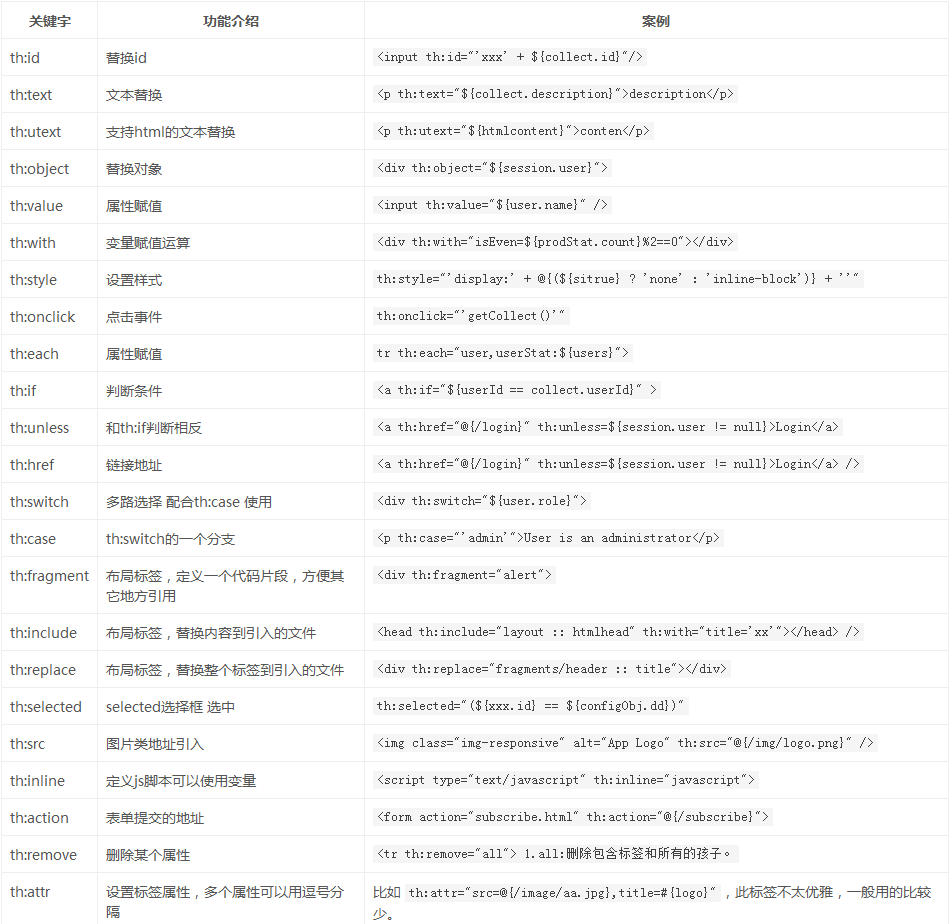初识Thymeleaf:简单表达式和标签
- 一、th简单表达式:
- 二、th常用标签:
一、th简单表达式:
① ${…} 变量表达式:
<input type="text" name="userName" value="Beyrl" th:value="${user.name}" />
上述代码为引用user对象的name属性值。
② *{…} 选择表达式:
<div th:object="${session.user}">
<p>Nationality: <span th:text="*{nationality}">XXXX</span>.</p>
</div>
选择表达式一般跟在th:object后,直接选择object中的属性。
③ #{…} 消息文字表达式:
<p th:utext="#{home.welcome}">Welcome to our grocery store!</p>
④ @{…} 链接url表达式:
<a href="details.html" th:href="@{/webPage/details(orderId=${o.id})}">view</a>
@{……}支持决定路径和相对路径。其中相对路径又支持跨上下文调用url和协议的引用(//code.jquery.com/jquery-2.0.3.min.js)。
当URL为后台传出的参数时,代码如下:
<img src="../../webPage/food/images/pizza.jpg" th:src="@{${path}}" alt="披萨" />

二、th常用标签:
1.th????
类似html标签中的id属性。
<div class="student" th:id = "food+(${pizza.index}+1)"></div>
2.th:text:与th:utext:
即文本显示,可对表达式或变量求值,并将结果显示在其被包含的HTML标签内,替换原有HTML文本。这里需要与th:utext:区分开,th:text:例子如下:
//若 restraunt.welcome=welcome to our <b>delicious</b>restaurant!
<p h:text="#{restaurantt.welcome}"></p>
//解析的结果为: welcome to our <b>delicious</b>restaurant!
<p h:utext="#{restaurant.welcome}"></p>
//转义最终输出的结果为:welcome to our delicious restaurant!
3.th:object:
用于表单数据对象绑定,将表单绑定到后台controller的一个JavaBean参数,常与th:field一起使用进行表单数据绑定。选择表达式一般跟在th:object后,直接取object中的属性。
这里有一个需要注意的点:{…}表达式的值是在选定的对象而不是整个context的map。也就是说,如果没有选定的对象,{…}和${…}没有区别,请看下面的例子:
<div th:object="${session.user}">
<p>姓名:<span th:text="*{Name}">noodles</span></p>
<p>年龄:<span th:text="*{age}">24</span></p>
<p>国籍:<span th:text="*{nationlity}">中国</span></p>
</div>
//等同于
<div>
<p>姓名:<span th:text="${session.user.Name}">noodles</span></p>
<p>年龄:<span th:text="${session.user.age}">24</span></p>
<p>国籍:<span th:text="${session.user.nationlity}">中国</span></p>
</div>
4.th:field:上面提到了一个新标签,th:field:,常用于表单字段绑定。通常与th:object一起使用。 属性绑定、集合绑定。
<form th:action="@{/bb}" th:object="${user}" method="post" th:method="post">
<input type="text" th:field="*{name}"/>
<input type="text" th:field="*{msg}"/>
<input type="submit"/>
</form>
5.th:action:定义后台控制器路径,类似标签的action属性。
<form action="subscribe.html" th:action="@{/subscribe}">
6.th:href:定义超链接,类似a标签的href 属性。value形式为@{/logout}.
<!-- 输出: 'http://localhost:8080/gtvg/order/details?orderId=3' -->
<a href="details.html"
th:href="@{http://localhost:8080/gtvg/order/details(orderId=${o.id})}">view</a>
<!-- 输出: '/gtvg/order/details?orderId=3' -->
<a href="details.html" th:href="@{/order/details(orderId=${o.id})}">view</a>
<!-- 输出: '/gtvg/order/3/details' -->
<a href="details.html" th:href="@{/order/{orderId}/details(orderId=${o.id})}">view</a>
7.th:src:用于外部资源引入,类似于
<script th:src="@{/js/jquery/jquery-2.4.min.js}">
8.th:value:用于标签赋值,类似标签的value属性。
<option th:value="soup">soup</option>
<input id="msg" th:value="${msg}" />
9.th:if or th:unless:条件判断,支持布尔值,数字(非零为true),字符,字符串等.
<div th:if="${restaurant.index} == 0">... I love eating(do something at here) ...</div>
<span th:if="${food.price lt 100}" class="offer">Special desert!</span>
/*不能用"<",">"等符号,要用"lt"等替代*/
<select class='form-control' name="skill[4].proficiency">
<option >掌握程度</option>
<option th:if="${skill.level eq '一般'}" th:selected="selected">一般</option>
<option th:if="${skill.level eq '熟练'}" th:selected="selected">熟练</option>
<option th:if="${skill.level eq '精通'}" th:selected="selected">精通</option>
</select>
最后
以上就是谨慎枕头最近收集整理的关于初识Thymeleaf:简单表达式和标签一、th简单表达式:二、th常用标签:的全部内容,更多相关初识Thymeleaf内容请搜索靠谱客的其他文章。








发表评论 取消回复